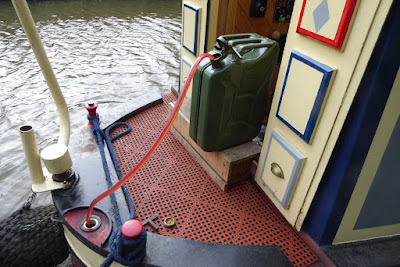At Brinklow CRT is getting round the landslip problem by literally getting round it. A temporary floating walkway has been constructed over the edge of the canal bypassing a not that huge pile of rock and earth on the towpath.
Everything was going swimmingly for us until Sutton Stop. As we entered the stop lock I suddenly found that I could not disengage astern gear. All I could do was kill the engine. We descended the lock and I pulled the boat out onto the lock landing on the right, where we would be out of the way. The Morse control lever felt most peculiar; it didn't take long for me to diagnose a broken cable. The photo below shows a short length of inner cable (running bottom left to centre), still connected to the gearbox lever on the left, and the outer cable (on the right) now hanging free.
Within three miles of where we were now stranded live two sets of friends. The first were on holiday in Suffolk. The second had gone to Baddesley Clinton, fortunately not by boat. Stephen drove back while we had lunch, then took me to Springwood Haven where I bought a replacement cable (having removed the old one and measured its length). Back at the boat I fitted the cable. It was two inches shorter than the original, but there was plenty of slack so that was not a problem.
I had not done this before, so I discovered that what holds the outer in position at each end is a toroidal channel in the metal part next to the black plastic sheathed flexible part. This channel at the gearbox end is held by a brass clip secured by two bolts, lock washers and nuts. The clip has a protruding ridge which engages in the channel. At the Morse control end the channel is held in position by a small brass U-shaped pin. The protruding parts of the U are of unequal lengths. This pin goes through holes in the hard plastic "socket"; the longer part of the pin is bent over to stop it falling out.
The photo below shows the back of the Morse control; the two thick black cables are the throttle (going into the red housing) and the gearbox (black). The U-pins are inserted from the left in both cases; I have already removed the gearbox cable one.
At the gearbox end the inner cable screws into a brass piece which pokes through a hole in the lever and is prevented from falling out by a split pin. The photo shows me inserting this split pin.
Here is the gearbox end of the cable all fitted. The brass clip with its détente can be seen to the left.
I am very grateful to Stephen for his advice, especially on measuring the distance the inner extends from the outer at each end on the old cable, and making sure the new cable's measurements are the same. I did this and found everything worked perfectly when I started up again.
Interestingly - and could this be the cause of the failure? - the cable shows it has partially melted where it ran against the (fibreglass bandaged) exhaust. The new cable presses against the exhaust in the same way and cannot be rerouted as it is close to the gearbox clamp. I need to insert a thin piece of something heat resistant to protect it. Ideas, anyone?
We thought that was the end of the excitement for the day but, just an hour later, the engine began losing power. Yes, we had run out of diesel! We always have a full jerry can on board so in went 20 litres to get us out of trouble. We had stopped by a long stretch of piling just south of Marston Junction. Very handy again.
Before this emergency top-up (and I know, the jerry can is now empty) I sucked out a lot of crud and water from the bottom of the tank. It separates from the diesel immediately in the jam jars I put it in; I'll provide a photo later.
A tale of two locations
-
I woke this morning after a very long sleep last night to snow at the
cottage and a photos from our boaty neighbour Mandy off NB Don't Panic. I
do feel ...
1 day ago






























2 comments:
For heat protection how about some plumbers matting - I have an old piece used many times to protect things behind a sweated joint - cheapish and flexible. https://www.screwfix.com/p/rothenberger-plumbers-soldering-mat/54910
Although not as thin, Rockwool should insulate and stand the heat required in this situation and probably a better use than where I've seen it used for insulating in some boats!
Post a Comment